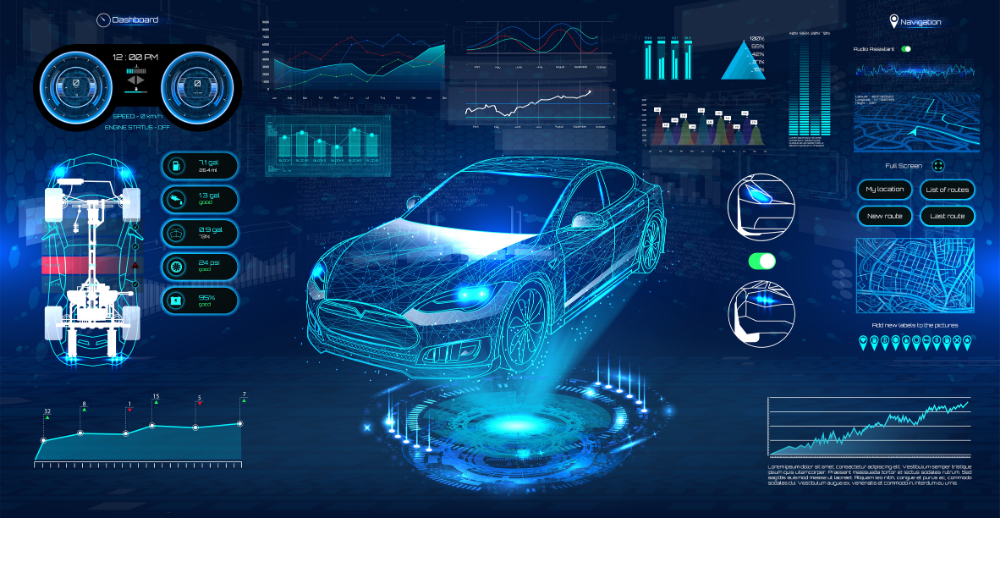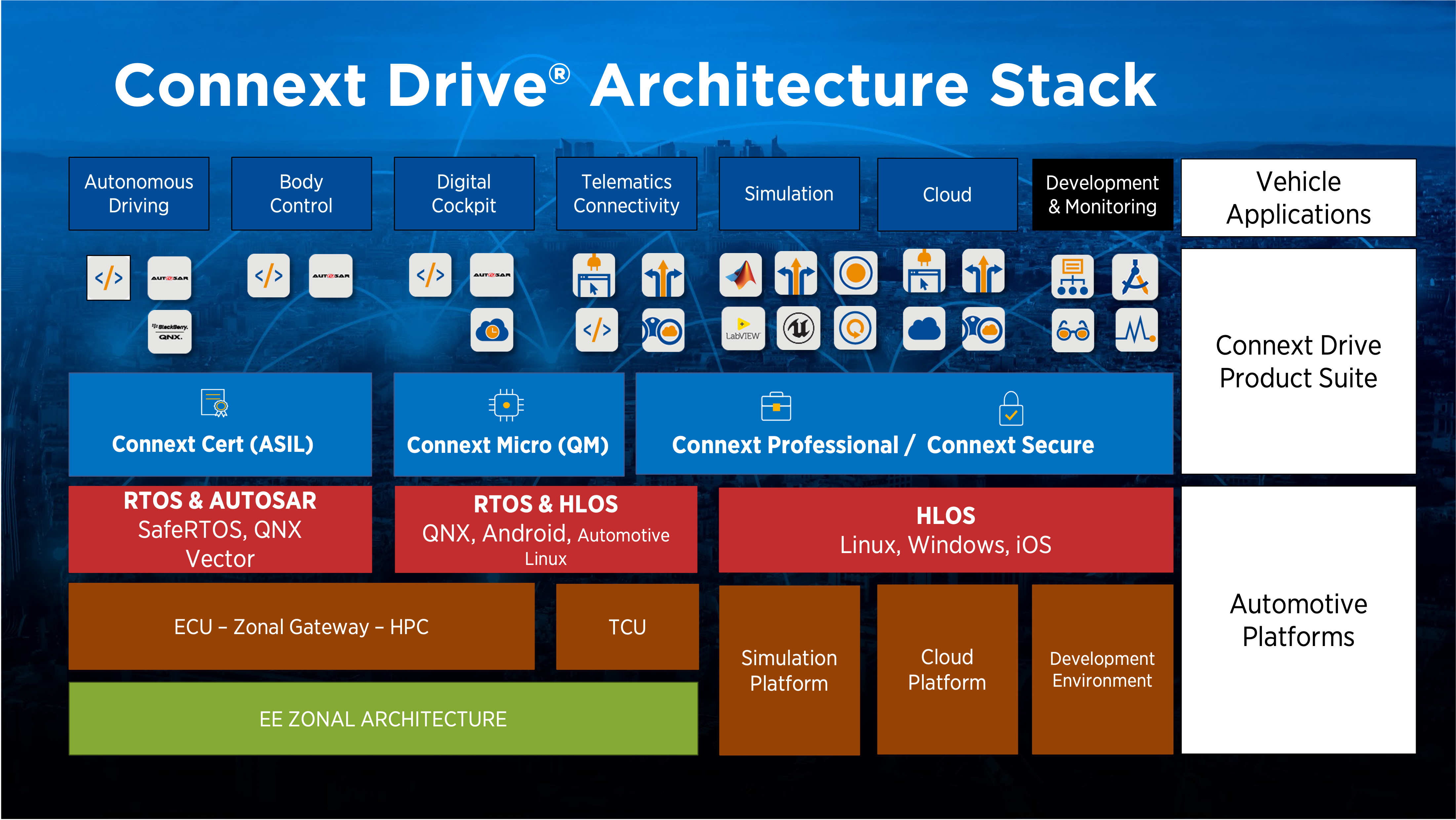3 min read
SDV Advancements: Enhancing Automotive Safety and Efficiency with Connext Drive 3.0
 Angel Berrio Moreno
:
November 9, 2023
Angel Berrio Moreno
:
November 9, 2023

The automotive industry is experiencing a transformative shift as it advances toward software-defined vehicles (SDVs). With the integration of cutting-edge technologies such as autonomous driving, connectivity features and advanced driver assistance systems (ADAS), the complexity of the vehicle's software systems has grown exponentially. In this new era of automotive innovation, the need for flexible development and innovative architectural solutions becomes more crucial than ever. This blog post focuses on Functional Safety Certification and AUTOSAR Adaptive / AUTOSAR Classic integration, which helps deliver the flexibility needed for safe, reliable, and future-proof software-defined vehicles.
Challenge: Functional Safety for SDVs
Functional safety certification is a fundamental aspect of ensuring the reliability and safety of automotive software. The primary objective of functional safety in the vehicle is to minimize the risk of accidents caused by software failures. In addition, functional safety certification enhances the trustworthiness of software products and increases market competitiveness.
However, while functional safety certification is essential, it can be a time-consuming and costly process. One of the major challenges is the need for recertification with each software change or update, delaying product releases, increasing costs and, ultimately, stifling innovation. Traditional software development practices often involve tightly coupled architectures and dependencies, leading to a domino effect where any modification in the software core requires recertification of the entire system.
Solution: Platform Independence for Functional Safety Certified Software
To address the challenges posed by recertification, it’s critical for OEMs to adopt a platform-independent approach. This allows for the separation of safety-critical functionality from the underlying software platform, promoting modularity and the reusability of safety-critical software components. With platform independence, only the platform-specific parts of the software need recertification for changes or updates. The safety-critical core remains unchanged, significantly reducing the scope and effort required for recertification. As a result, development teams can streamline the certification process and maintain compliance more effectively.
AUTOSAR: Paving the Way for SDVs
As an industry-standard framework, AUTOSAR (Automotive Open System Architecture) greatly simplifies the development of automotive software by providing a common platform for applications and electronic control units (ECUs). In recent years, AUTOSAR Adaptive has emerged as a key enabler for software-defined vehicles. Unlike the traditional AUTOSAR Classic, which is designed for static systems, AUTOSAR Adaptive is uniquely optimized for dynamic and highly-connected architectures.
While AUTOSAR Adaptive is driving innovation in software-defined vehicles, AUTOSAR Classic remains essential for supporting legacy systems and ensuring backward compatibility. Many vehicles on the road today rely on AUTOSAR Classic, and it continues to be a robust and well-established framework for automotive software development.
Safety remains of paramount importance in the automotive industry, and it’s no surprise that software-defined vehicles must meet quite stringent safety standards. Within this context, OEMs are increasingly moving toward a combination of AUTOSAR Adaptive, AUTOSAR Classic and the Data Distribution Service (DDS™) data-sharing protocol to enable full-system data interoperability, which in turn delivers the safety and reliability needed to bring SDVs to market efficiently.
What does DDS bring to the table? DDS facilitates real-time data exchange for safety-critical applications. This critical capability improves performance for AUTOSAR Adaptive, enabling it to provide continuous updates and upgrades, allowing for swift responses to potential vulnerabilities. DDS also accelerates this process in legacy systems, strengthening AUTOSAR Classic's ability to ensure overall safety and stability.
Introducing Connext Drive 3.0
Today, we are proud to announce the release of RTI Connext Drive® 3.0. Connext Drive 3.0 is the industry’s first platform-independent, certified communications framework, enabling distributed teams to match functional safety and flexibility for tomorrow's challenges. Based on the DDS standard, Connext Drive 3.0 accelerates development for next-generation SDVs through its focus on functional safety; its extended integration with AUTOSAR Classic and Adaptive and other platforms; and its unmatched architectural flexibility.
What are the key advantages of Connext Drive?
- Built for Safety: Connext Drive 3.0 is the first DDS-based, platform-independent communications framework that adheres to the highest functional safety standards (ISO26262 ASIL D).
- Future-proof and Flexible: Connext Drive 3.0 enables OEMs to embrace change effortlessly. With the new platform-independent ASIL-D TUV SUD-certified software, there is no need for recertification if the vehicle OS or network interfaces changes. Developers can use the same framework from prototype to production.
- Bridges the Platforms Gap: Connext Drive 3.0 seamlessly connects between DDS and AUTOSAR Classic/AUTOSAR Adaptive, while the new toolkit rapidly bridges development environments and eliminates the need for custom code.
With these advancements, OEMs can prototype, build and run their software-defined vehicles more rapidly, securely and confidently. To learn more about RTI Connext Drive, or to take the latest version for a free trial test-drive, please click here.

About the author:
 Angel Berrio Moreno is the Group Product Manager for Automotive and Aviation products at Real-Time Innovations (RTI). In this position he manages RTI’s global automotive and aviation product strategy and helps drive the Object Management Group (OMG®) DDS industry standard into the automotive and aviation market with RTI’s Connext software.
Angel Berrio Moreno is the Group Product Manager for Automotive and Aviation products at Real-Time Innovations (RTI). In this position he manages RTI’s global automotive and aviation product strategy and helps drive the Object Management Group (OMG®) DDS industry standard into the automotive and aviation market with RTI’s Connext software.
Posts by Tag
- Developers/Engineer (177)
- Connext DDS Suite (77)
- Technology (74)
- News & Events (73)
- 2020 (54)
- Standards & Consortia (51)
- Aerospace & Defense (48)
- Automotive (35)
- 2023 (34)
- 2022 (29)
- IIoT (27)
- Leadership (24)
- 2024 (22)
- Cybersecurity (20)
- Healthcare (20)
- 2021 (19)
- Connectivity Technology (16)
- Military Avionics (15)
- Culture & Careers (14)
- FACE (13)
- Connext DDS Pro (10)
- JADC2 (10)
- ROS 2 (10)
- 2025 (8)
- Connext DDS Tools (7)
- Connext DDS Micro (6)
- Databus (6)
- Transportation (5)
- Case + Code (4)
- Connext DDS (4)
- Connext DDS Cert (4)
- Energy Systems (4)
- FACE Technical Standard (4)
- Oil & Gas (3)
- RTI Labs (3)
- Research (3)
- Robotics (3)
- #A&D (2)
- Connext Conference (2)
- Edge Computing (2)
- MDO (2)
- MS&T (2)
- TSN (2)
- ABMS (1)
- C4ISR (1)
- ISO 26262 (1)
- L3Harris (1)
- LabView (1)
- MathWorks (1)
- National Instruments (1)
- Simulation (1)
- Tech Talks (1)
- UAM (1)
- Videos (1)
- eVTOL (1)
 Success-Plan Services
Success-Plan Services